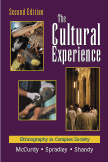“I was seeking a short and to-the-point book on ethnography with case studies. I found this to be the exact fit to supplement my class textbook.” — Karen Oeh, Las Positas College
“A worthy successor to the first edition. The expanded section on method is excellent—very grounded and operationalized, thus very accessible for students. The sample ethnographies look interesting enough that it will be easy to get the students to read them.” — J. H. Holland, Hobart-William Smith Colleges
“Good and much-needed update to an extremely valuable learning tool for those new to ethnography. The student ethnographies are excellent examples of how relevant this methodology is to understanding the world around us in all its complexities. The additional materials, including boxed inserts, add to the discovery process.” — Cynthia Vanda, University of Pittsburgh
“Great book at a great price!” — Paul D. Starr, Auburn University
“My students loved it. They appreciated the ethnographic vignettes for its quick look at the finished product of qualitative research.” — Mary Ann Pitman, University of Cincinnati

190 pages, $33.95 list
1-57766-364-0
978-1-57766-364-5
© 2005
paperback
eBook availability
Also by
James P. Spradley
James P. Spradley
The Cultural Experience
Ethnography in Complex Society
Second Edition
The Cultural Experience has helped generations of undergraduates discover the excitement of ethnographic research through participation in relatively familiar cultures in North American society. Grounded in the interviewing-based ethnographic technique known as ethnosemantics, the latest edition continues to treat ethnography as a discovery process. Students are taught how to set up an ethnographic field study, choose a microculture, and find and approach an informant, as well as how to ask ethnographic questions, record data, and organize and analyze what they have learned. Detailed instruction on how to write an ethnography is also provided. The guidelines are followed by ten short but substantive, well-written student ethnographies on such microcultures as exotic dancing, firefighting, pest extermination, and the work of midwives and police detectives.
The Second Edition of this popular classroom volume includes boxed inserts that offer suggestions to aid in the research process, material on how to use observation and narratives with the ethnosemantic approach, an emphasis on how to find cultural themes and adaptive challenges by analyzing ethnographic field data, and extensive strategies for writing the final ethnographic paper. It also presents a comprehensive treatment of ethical responsibilities as well as a discussion of the significance of ethnographic research and its applications in the workplace.
The Second Edition of this popular classroom volume includes boxed inserts that offer suggestions to aid in the research process, material on how to use observation and narratives with the ethnosemantic approach, an emphasis on how to find cultural themes and adaptive challenges by analyzing ethnographic field data, and extensive strategies for writing the final ethnographic paper. It also presents a comprehensive treatment of ethical responsibilities as well as a discussion of the significance of ethnographic research and its applications in the workplace.
Reactions
Part I. DOING ETHNOGRAPHY
1. Culture and Ethnography
2. Microcultures
3. Cultural Informants
4. Discovering Folk Terms
5. Discovering Taxonomic Structure
6. Discovering Meaning
7. Ethnographic Detail and Cultural Focus
8. Cultural Themes and Cultural Adaptation
9. Writing and Using Ethnography
Part II. STUDENT ETHNOGRAPHIES
• Getting the Truth: The Police Detective and the Art of Interviewing (Cole Akeson)
• Juicing Their Way to the Top: Ethnography of a Tattoo Shop (Jennifer Boehlke)
• No Money, No Honey: An Ethnography of Exotic Dancers (Melissa Cowell)
• Where Did Time Go?: A Look into a Jesuit Pastor's Struggle with Time (Meghan Greeley)
• "Alice in Wonderland": The Culture of a Neighborhood Flower Shop (Sana Haque)
• Dealing with Dickheads: An Ethnography of a Nightclub Staff Member (John Hoch)
• Ethnography of a Legal Secretary (Jordan Pender)
• Coping with Stress: An Ethnography of Firefighters (Alex Rubenstein)
• The Modern Pest Control Revolution (Byron Thayer)
• Catching Babies: An Ethnography of a Licensed, Traditional Midwife (Natasha Winegar)
1. Culture and Ethnography
2. Microcultures
3. Cultural Informants
4. Discovering Folk Terms
5. Discovering Taxonomic Structure
6. Discovering Meaning
7. Ethnographic Detail and Cultural Focus
8. Cultural Themes and Cultural Adaptation
9. Writing and Using Ethnography
Part II. STUDENT ETHNOGRAPHIES
• Getting the Truth: The Police Detective and the Art of Interviewing (Cole Akeson)
• Juicing Their Way to the Top: Ethnography of a Tattoo Shop (Jennifer Boehlke)
• No Money, No Honey: An Ethnography of Exotic Dancers (Melissa Cowell)
• Where Did Time Go?: A Look into a Jesuit Pastor's Struggle with Time (Meghan Greeley)
• "Alice in Wonderland": The Culture of a Neighborhood Flower Shop (Sana Haque)
• Dealing with Dickheads: An Ethnography of a Nightclub Staff Member (John Hoch)
• Ethnography of a Legal Secretary (Jordan Pender)
• Coping with Stress: An Ethnography of Firefighters (Alex Rubenstein)
• The Modern Pest Control Revolution (Byron Thayer)
• Catching Babies: An Ethnography of a Licensed, Traditional Midwife (Natasha Winegar)